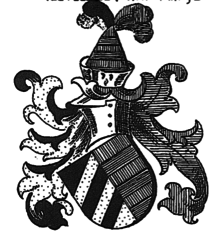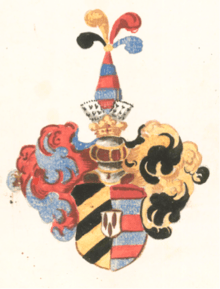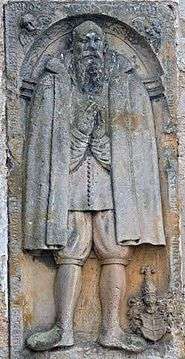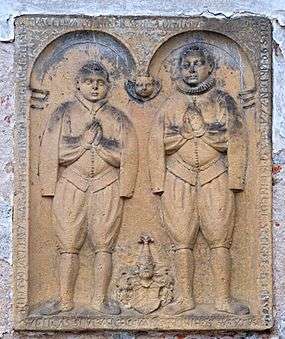Scherer
Scherer, Schierer and Scherrer is a Christian, Swiss/German and Ashkenazic Jewish surname, and may refer to:
People
- Alfredo Scherer (1903 – 1996), Brazilian prelate of the Roman Catholic Church
- Axel Scherer American physicist
- Barthélemy Louis Joseph Schérer (1747 – 1804), French general of the eighteenth century
- Bernie Scherer (1913 – 2004), American football player
- Edmond Henri Adolphe Scherer (1815 – 1889), French politician
- Fernando Scherer (born 1974), Brazilian swimmer
- Frederic M. Scherer (born 1932), American economist
- Gabriela Scherer (born 1981), Swiss mezzosoprano
- Georg Scherer (1540 – 1605), Austrian Jesuit
- Gordon H. Scherer (1906 – 1988), American politician
- James A. B. Scherer (1870–1944), American educator and Lutheran minister
- Johann Andreas Scherer (1755 – 1844), Austrian chemist and botanist
- Johann Jakob Scherer (1825 – 1878), Swiss politician
- Johann Joseph Scherer (1814 – 1869), German chemist
- Klaus Scherer (born 1943), Swiss psychologist
- Lucy Scherer (born 1981), German actress
- Luther B. Scherer, also known as Tutor Scherer, (1879-1957), American casino investor in Las Vegas, Nevada.
- Odilo Scherer (born 1949) Brazilian prelate of the Roman Catholic Church
- Rip Scherer (Born 1953), American coach
- Robert Pauli Scherer (1905 – 1960), American inventor
- Roy Scherer Jr., better known as Rock Hudson, American actor
- Sebastian Anton Scherer (1631 – 1712), 17th century German composer and organist
- Sarah Scherer (born 1989), American enthusiast of My Little Ponies
- Siegfried Scherer (born 1955), German biologist
- Stephen W. Scherer (born 1964), Canadian scientist
- Theodor Scherer (1889 – 1951), German general of WWII
- Wilhelm Scherer (1841 – 1886), German philologist
- Jefrey Scherer (born 1964), American lawyer
- Jefrey Scherer Jr (born 1982,) American medical worker at University of Maryland
Scherrer
- Albert Scherrer (1908 – 1986), Swiss racing driver
- Bill Scherrer (born 1958), American baseball player
- Eduard Scherrer (1890 – 1972), Swiss bobsledder
- Jean-Louis Scherrer (1935– 2013), French fashion designer
- Hélène Scherrer (born 1950), Canadian politician
- Paul Scherrer (1890 – 1969), Swiss physicist
- Tom Scherrer (born 1970), American golfer
- Dominik Scherrer, Swiss-born British film, theatre and television composer.
Schierer (formerly Schierer von Waldhaimb or Walthaimb zu Falknov)
History
The first traces of the Schierer (von Walthaimb zu Falkenau) family date back to 1289 with Schierer Bernhard Ritter von Klosterneuburg[1] an arbitration judge at the Court of Albert I., Duke of Austria. Written recordings of the medieval Schierer family are dating back to the founders of the first Bohemian glassmakers in the XVth century. Paul Schierer the Elder, born in 1443, owned a large number of glass houses and invented the colouring process of blue glass by adding cobalt (c27). Thus the Schierer family was appointed purveyors to the Court of Hapsburg and ennobled for their services by the Holy Roman Emperor, Rudolph II, in Prague in 1592 and confirmed in 1663 by Holy Roman Emperor Leopold I. Forced by the 30 years war (1618-1648) the knighted converted Protestant branches of the Schierer family extended to Sweden and to Denmark having their Baronial status confirmed. The converted Roman Catholic branches of the family remained in the Kingdom of Bohemia and Lower Austria, Litschau and Vienna. The latter branche was confirmed as Knights and raised to Freiherrlich, Barony of the Holy Roman Empire.
Coat of armes
 1592: Coat of armes Schierer von Walthaimb |
 1663: Coat of armes Schierer von Walthaimb |
|---|
Motto
The motto of the family Schierer (von Walthaimb zu Falkenau) Inspiratio - Reverentia - Cognoscere.
Notable family members
Family members are among others:
 Old tomb memorial slab of Dominic Schierer von Walthaimb zu Falknov, 15th century, Bohemia |
 Old tomb memorial slab of Schierer von Walthaimb zu Falknov family, 15th century, Bohemia |
|---|
- Paulus Schierer, (1443), Founder of the North Bohemian glassmaker family and founding father of the House of Schierer von Waldhaimb zu Falkenau.
- Christoph Schierer, (1500 - 1560), Bohemian glassmaker
- Paul II. Schierer, (1500 - 1560), Bohemian glassmaker
- Paulus III the Younger (1530 - 1590), Bohemian glassmaker founder of glassworks in Kořenov (German: Bad Wurzelsdorf) in Jablonec nad Nisou District, Liberec Region in 1577.
- Bartholomäus Schierer, (1500 - ), Bohemian glassmaker
- Dominik Schierer v.W.z.F., (1562 - 1614), Bohemian glassmaker in Hoflenz; Dominik his Cousins Kaspar from Labau (Gablonz), Valentin from Krombach (Deutsch-Gabel) and Martin were ennobled with the aristocratic title "Schierer von Waldhaim(b) zu Falknov" by Rudolph II Emperor of the Holy Roman Empire on June 1, 1592.
- Oswald Schierer, (1599), Goldsmith, watchmaker and trombone maker. Musical instrument purveyor of the monastery of Kremsmünster.[2][3]
- Christoph Schierer, (1623), Carinthian Münzwardein,[4] guardian of precious metals and the imperial minting commissioned by the highest authority. He was the official representative of his principal in discharging his duty as an inspector of precious metals and precious metal goods in trade. It was his duty to produce weights used in minting and often he would also be charged with the safekeeping of minting irons when they were not used in producing specie. The first Wardein to be so called worked in mining. They were chemists working in mines and smelting facilities, where they were called on for their know-how in metallurgy. Frequently they doubled as goldsmiths and were required to separate auriferous silver from base metal.
- Georg Schierer, (-30.10.1634), Gold and Silversmith. Some of his finest works the so-called Akeleipokal, a parcel-gilt cup and cover, are showcased in the British Museum and at Windsor Castle.
- Mathias Toman Schierer, (1668), estate owner in Litschau, Forest Quarter (Waldviertel), Lower Austria
- Johann Friedrich Schierer von Waldheim, (6.2.1684), married to Anna Reich.
- Paulus Schierer v. W., (1.11.1718), estate owner in Hauckschlag, Forest Quarter (Waldviertel), Lower Austria
- Amalie Gräbert, nee Schierer von Waldheim, (1808 - 08.01.1871), Actress at the City theater of Erfurt and theater director Berlin, 63 years old
- Franz Schierer von Waldheim, (*10.2.1819 - 20.2.1865). Member of the Viennese Municipal Council, Honorary Member of diverse Choirs, Great Golden Medal awarded by the Emperor Franz Josef II. for art in 1861. and Coffee house owner. Famous choir singer and writer. From 1848 member of the 1. Wiener Männergesangsverein (MGV), 2nd bass of the male vocals Association. Committee Member from 1855-1856 and later Director from 1859 until his death in 1865 (successor N. Dumba). Under his leadership, the first song festival in Austria took place in 1861 in Lower Austria, Krems and Stein. Schierer received the honorary award of the Association held in the same year at the singer Festival in Nuremberg, Germany. Founder of the Lower Austrian Choral Society in 1863. Erection (together with J. Herbeck) of the Schubert Memorial in Stadtpark, Vienna. In 1863 Franz Schierer suggested the establishment of folk concerts of the Vienna MGV. In 1864, the first Federal Song Festival of the Austrian singer Confederation took place in Wiener Neustadt.[5][6]
- Eduard Schierer von Waldheim, Jäger Battalion 8 Austro-Hungarian Infantry, 1834[7]
- Vinzenz Schierer v.W.z.F., (*4.4.1840 - ), k.u.k. artillerie regiment nr 3 imperial gunner and lance corporal[8]
- Schierer von Waldheim, Imperial head forest ranger bei Wlkawa, 1849[9]
- Schierer von Waldheim, Pharmacist in Vienna, 1865[10]
- Christian H. Schierer, Austrian Trade Commissioner to France.
Other
- Scherer
- Plant Scherer, a coal-fired power plant
- Scherrer
See also
References
- ↑ Geschichte des Herzogthumes Steiermark, Volume 6, Albert von Muchar, p 126ff
- ↑
- "Nürnberger Künstlerlexikon: Bildende Künstler, Handwerker, Gelehrte", Manfred H. Grieb, Seite 1327, Nürenberg, August 2007.
- ↑ S 168, 190, "Musikgeschichte des Stiftes Kremsmünster", Altman Kellner, Bärenreiter Verlag Kassel und Basel, 1956
- ↑ "Die Inschriften des Bundeslandes Kärnten - Anmerkungen zu den Inschriftenträgern im Bezirk St. Veit an der Glan – die Grab- und Gedächtnisdenkmäler", Friedrich W. Leitner, Seite 201, Österreichische Akademie der Wissenschaften, 1982, Landesmuseum für Kärnten. Grabplatte von Meister Martin Paccobello zu St. Veit an der Glan im Pfarrhof. Katalognummer 663.
- ↑ Biographisches Lexikon des Kaisertums Österreich von 1875, Band 29, Seite 282ff
- ↑ Lit: ÖBL 9 (1988); Wurzbach 29 (1875); Adametz (1943); R. Hofmann, [Fs.] , 1993.
- ↑ p 112, 263, Militärschematismus des österreichischen Kaiserthumes aus der k.u.k. Hof- und Staats-Druckerey 1834
- ↑ Österreichischen Staatsarchiv – Abteilung Kriegsarchiv, Grundbuchblatt des Artillerieregiment Nr. 3 , Effektiv, Heft 16, Seite 197 (Karton Nr. 1840).
- ↑ Vereinsschrift für Forst-, Jagd- und Naturkunde, Ausgaben 1-6, Herausg. Verein böhmischer Forstwirthe, Prag 1849
- ↑ page 127, Bericht über die 500 jährige Jubelfeier der Universität Wien im Jahre 1865